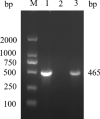First detection and molecular identification of Babesia sp. from the giant panda, Ailuropoda melanoleuca, in China
- PMID: 33121531
- PMCID: PMC7597363
- DOI: 10.1186/s13071-020-04412-8
First detection and molecular identification of Babesia sp. from the giant panda, Ailuropoda melanoleuca, in China
Abstract
Background: Parasitic infections are among the important causes of death of giant pandas (Ailuropoda melanoleuca) that hamper their survival in the wild. There are about 35 species of parasites which have been identified in giant pandas, but no information is currently available regarding the infection of Babesia in giant pandas. Babesia spp. are common intraerythrocytic parasite in wildlife, transmitted by ixodid ticks, which cause babesiosis. Clinical signs of babesiosis include fever, hemolysis, anemia, jaundice and death.
Methods: A species of Babesia was detected in the blood of a giant panda based on morphology and PCR amplification of the 18S rRNA gene. The phylogenetic relationship of Babesia sp. infecting giant panda was assessed by gene sequence alignment and phylogenetic analysis.
Results: Our analysis revealed that the Babesia isolate detected was most similar to an unidentified species of Babesia identified in black bears (Ursus thibetanus japonicus) from Japan (Babesia sp. Iwate, AB586027.1) with a 99.56% sequence similarity, followed by Babesia sp. EBB (AB566229.1, 99.50%) and Babesia sp. Akita (AB566229.1, 99.07%).
Conclusions: To our knowledge, this is the first report of Babesia detected in the giant panda. The results indicate that this Babesia sp. may be a novel species, currently named Babesia sp. strain EBP01.
Keywords: 18S rRNA gene; Babesia; Giant panda; Phylogenetic tree; ailuropoda melanoleuca.
Conflict of interest statement
The authors declare that they have no competing interests.
Figures




Similar articles
-
Description and molecular characterisation of Babesia ailuropodae n. sp., a new piroplasmid species infecting giant pandas.Parasit Vectors. 2024 Jul 20;17(1):315. doi: 10.1186/s13071-024-06402-6. Parasit Vectors. 2024. PMID: 39033131 Free PMC article.
-
The first detection of Babesia species DNA from Japanese black bears (Ursus thibetanus japonicus) in Japan.Parasitol Int. 2011 Jun;60(2):220-2. doi: 10.1016/j.parint.2011.02.005. Epub 2011 Mar 2. Parasitol Int. 2011. PMID: 21376138
-
A new piroplasmid species infecting dogs: morphological and molecular characterization and pathogeny of Babesia negevi n. sp.Parasit Vectors. 2020 Apr 21;13(1):130. doi: 10.1186/s13071-020-3995-5. Parasit Vectors. 2020. PMID: 32312309 Free PMC article.
-
Review on parasites of wild and captive giant pandas (Ailuropoda melanoleuca): Diversity, disease and conservation impact.Int J Parasitol Parasites Wildl. 2020 Jul 28;13:38-45. doi: 10.1016/j.ijppaw.2020.07.007. eCollection 2020 Dec. Int J Parasitol Parasites Wildl. 2020. PMID: 32793415 Free PMC article. Review.
-
Parasites of the Giant Panda: A Risk Factor in the Conservation of a Species.Adv Parasitol. 2018;99:1-33. doi: 10.1016/bs.apar.2017.12.003. Epub 2018 Feb 16. Adv Parasitol. 2018. PMID: 29530307 Free PMC article. Review.
Cited by
-
Efficacy of azithromycin combined with compounded atovaquone in treating babesiosis in giant pandas.Parasit Vectors. 2024 Dec 23;17(1):531. doi: 10.1186/s13071-024-06615-9. Parasit Vectors. 2024. PMID: 39716228 Free PMC article.
-
Cross-sectional analysis of Piroplasma species-infecting camel (Camelus dromedaries) in Egypt using a multipronged molecular diagnostic approach.Front Vet Sci. 2023 Apr 28;10:1178511. doi: 10.3389/fvets.2023.1178511. eCollection 2023. Front Vet Sci. 2023. PMID: 37187929 Free PMC article.
-
The bacterial diversity and potential pathogenic risks of giant panda-infesting ticks.Microbiol Spectr. 2025 Jul;13(7):e0219724. doi: 10.1128/spectrum.02197-24. Epub 2025 Jun 10. Microbiol Spectr. 2025. PMID: 40494644 Free PMC article.
-
Prevalence and genetic diversity of Babesia microti in rodents from central and southern Shanxi, China.Parasit Vectors. 2025 Jun 22;18(1):236. doi: 10.1186/s13071-025-06898-6. Parasit Vectors. 2025. PMID: 40545533 Free PMC article.
-
Complete Mitogenomes of Ticks Ixodes acutitarsus and Ixodes ovatus Parasitizing Giant Panda: Deep Insights into the Comparative Mitogenomic and Phylogenetic Relationship of Ixodidae Species.Genes (Basel). 2022 Nov 6;13(11):2049. doi: 10.3390/genes13112049. Genes (Basel). 2022. PMID: 36360286 Free PMC article.
References
MeSH terms
Substances
Grants and funding
LinkOut - more resources
Full Text Sources
Miscellaneous

